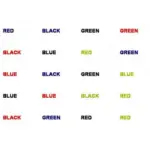Many people, during their visit to the virtual world, come across a widely shared post, in which they can read color names but which are written in different colors.
Below the image appears the typical question: are you able to say the color without reading the word? What may seem like just another Internet challenge is, in reality, a cognitive test, with its own associated effect.
The Stroop effect This is what is tested in this type of posts, and has been addressed experimentally. Below we will see in more depth what it is.
What is the Stroop effect?
The Stroop effect, also called the Jaensch effect, is a semantic interference that occurs due to having automated reading , causing us to unconsciously give priority to those stimuli that come in the form of written words before other modalities, such as shape or color. This phenomenon is named after the person who first described it, John Ridley Stroop.
Although we are going to go into more detail in the next section, we are going to try to explain very quickly how the effect happens. Let’s imagine that we have a list of words, each of them painted a different color and that, coincidentally, each word refers to the color in which they are written. For example, the word ‘BLUE’ is painted blue, the word ‘RED’ is painted red, and so on.
If we were asked to say the ink color of each word, it would be a very simple thing to do. It is possible that we limit ourselves to reading the words, knowing that each one of them does not ‘lie’ or ‘cheat’, since it refers to the color in which it is written. The problem comes when the written color and its ink do not correspond , for example, ‘GREEN’ written in yellow. We can no longer read, we have to look carefully at the color of each word, plus we will go slower and possibly make the odd mistake.
Reading is something that we have very automated. This is something that the vast majority of people who have the great gift of being literate do not notice. Reading each word, for anyone without problems such as dyslexia or very late literacy, is a very fast process. It is seeing the word and ‘click’, we have already read it and, depending on how abstract or concrete the concept it refers to, we have made a mental image of its meaning.
It is because of that, While it is very easy for us to read, it is very difficult for us to try to put aside this automatic process. We can’t just turn off reading. The Stroop effect is very difficult to avoid, since we have to make a great effort not to read aloud what is in front of us during the test.
How was it discovered?
This phenomenon is named after the person who first described it, John Ridley Stroop who published his research in 1935 in his article Studies of Interference in Serial Verbal Reaction.
In this article, published in the Journal of Experimental Psychology, Stroop applied two tests. One, called Reading Color Names or RCN, in which the subject had to read the written meaning of the words, which were written in different colors, while the other, called Naming Colored Words or NCW, the reader had to say the color of the ink in which the words were written.
Specifically in the NCW tests, the subject, who had to say the color of the ink of each of the words on the sheet, Stroop obtained very interesting results. Initially, the words shown to the participants were the same color as the ink in which they were written, that is, the word “BLUE” was blue, the word “RED” was red, “GREEN” , green….
When the subject was in this condition, he did not have much difficulty telling the color of the ink, since it corresponded to what was written. The problem came when they had to say the color of the ink in the word but the name of the color to which the word referred did not match. That is, the word “RED” but written in blue ink, “BLUE” in yellow, etc.
He saw that, in addition to more errors in this second condition, participants took longer to answer, since they had to “neutralize” their reading process , which is automated, and try to say only the color of the word they were seeing. It is this interference that is known as the Stroop effect in experimental psychology.
Attention is selective, that is, we focus it based on what interests us. However, if we try to focus on something trying to inhibit a response as automated as reading words, this becomes especially complicated. The Stroop effect occurs as a result of an interference between what we want to focus on and the reading that we can hardly ignore.
Are colors always used?
This same test has been replicated in other ways, without having to resort to colors alone.
An alternative way is feature animal names inside animal silhouettes too , which may or may not correspond to the animal written inside. For example, present the word “PIG” inside the figure of an elephant, or the word “DOG” inside that of a fish. Other versions include geometric figures (e.g. “TRIANGLE” inside a circle), country names, flags, fruits, and endless alternatives.
One of the reasons why these Stroop tests exist is, above all, the existence of people who have some type of color blindness , whether colorblind for one or two colors or blindness for any color. In the latter case, people see the world in white and gray, which makes it impossible to test their ability to see the ink color of words since color basically does not exist for them.
Importance of the Stroop effect in the diagnosis of ADHD
The Stroop effect occurs as a consequence of having automated reading, and it is a phenomenon that tests the person’s selective attention trying to avoid reading the word and saying some characteristic of that word, whether it be the color, the way it is presented or any other aspect.
Given this, the Stroop effect and, especially, the tests based on it have been very useful to study the cases of people who have been diagnosed with attention deficit hyperactivity disorder (ADHD), in addition to specifying its diagnosis.
ADHD, according to the DSM, is characterized by a sustained pattern of inattention , with or without the presence of hyperactive and impulsive behaviors. This pattern is more frequent and becomes more serious if it is compared to people who do not have any disorder and are at the same stage of development. These behaviors must manifest themselves in more than two different environments.
ADHD, although its diagnosis has been criticized, is, according to health authorities, one of the most important clinical problems in terms of dysfunction, from childhood to adulthood, causing problems in multiple spheres of a person’s life.
According to Barkley (2006), the central problem of this disorder is difficulty in inhibitory control, shown in the form of impulsivity and difficult control of cognitive interferences. This impacts executive functions such as working memory, both verbal and non-verbal, self-regulation, and the ability to synthesize and analyze.
The Stroop effect serves as a measure of people’s executive functioning, especially their ability to pay attention and concentrate. It allows us to measure selective attention and see how cognitively flexible or rigid the person is. It allows you to see if you are able to inhibit and control your dominant responses, in this case, reading words.
Cognitive flexibility refers to the ability to quickly and appropriately change one thought or behavior for another, according to what is being asked of the person in the task they are performing.
On the other hand, cognitive rigidity is understood as the degree of difficulty that a person may have in ignoring distractions, or the inability to control their incorrect responses, in this case, saying the name of the written word instead of the color of the ink. in which they are written.
The Stroop effect is considered a reflection of problems in the prefrontal area , which is in charge of executive functions. This test is of great importance in the field of neuropsychological evaluation thanks to its quick application and easy interpretation.
People with ADHD have a fairly rigid cognitive style, with difficulty inhibiting their behaviors compared to people without any developmental pathology. They show greater interference when saying the color of the words in the Stroop test without saying what is written.









